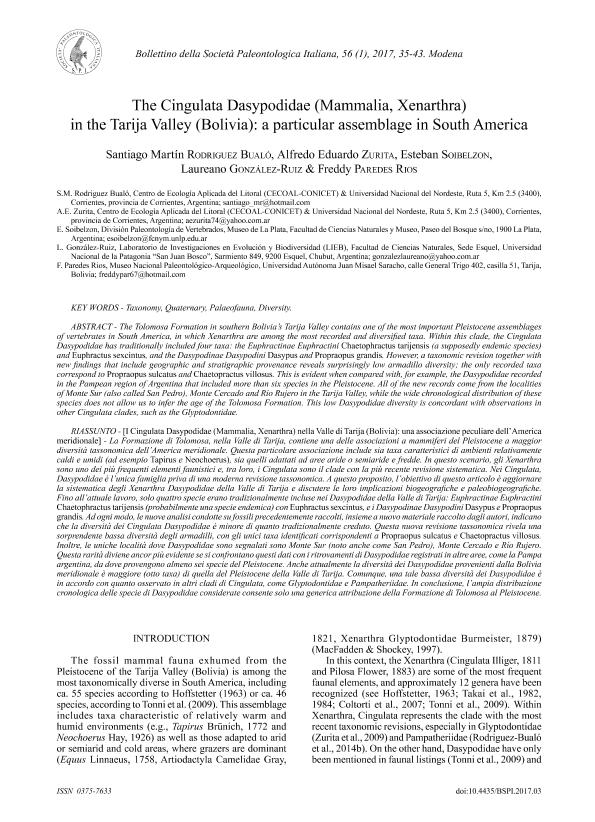Artículo
The Cingulata Dasypodidae (Mammalia, Xenarthra) in the Tarija Valley (Bolivia): A particular assemblage in South America
Título:
Cingulata Dasypodidae (Mammalia, Xenarthra) nella Valle di Tarija (Bolivia): Una associazione peculiare dell’America meridionale
Rodriguez Bualó, Santiago Martín ; Zurita, Alfredo Eduardo
; Zurita, Alfredo Eduardo ; Soibelzon, Esteban
; Soibelzon, Esteban ; Gonzalez Ruiz, Laureano Raul
; Gonzalez Ruiz, Laureano Raul ; Paredes Rios, Freddy
; Paredes Rios, Freddy
 ; Zurita, Alfredo Eduardo
; Zurita, Alfredo Eduardo ; Soibelzon, Esteban
; Soibelzon, Esteban ; Gonzalez Ruiz, Laureano Raul
; Gonzalez Ruiz, Laureano Raul ; Paredes Rios, Freddy
; Paredes Rios, Freddy
Fecha de publicación:
10/2017
Editorial:
Soc Paleontologica Italiana
Revista:
Bollettino Della Societa Paleontologica Italiana
ISSN:
0375-7633
Idioma:
Italiano
Tipo de recurso:
Artículo publicado
Clasificación temática:
Resumen
The Tolomosa Formation in southern Bolivia’s Tarija Valley contains one of the most important Pleistocene assemblages of vertebrates in South America, in which Xenarthra are among the most recorded and diversified taxa. Within this clade, the Cingulata Dasypodidae has traditionally included four taxa: the Euphractinae Euphractini Chaetophractus tarijensis (a supposedly endemic species) and Euphractus sexcintus, and the Dasypodinae Dasypodini Dasypus and Propraopus grandis. However, a taxonomic revision together with new findings that include geographic and stratigraphic provenance reveals surprisingly low armadillo diversity; the only recorded taxa correspond to Propraopus sulcatus and Chaetopractus villosus. This is evident when compared with, for example, the Dasypodidae recorded in the Pampean region of Argentina that included more than six species in the Pleistocene. All of the new records come from the localities of Monte Sur (also called San Pedro), Monte Cercado and Río Rujero in the Tarija Valley, while the wide chronological distribution of these species does not allow us to infer the age of the Tolomosa Formation. This low Dasypodidae diversity is concordant with observations in other Cingulata clades, such as the Glyptodontidae.
Palabras clave:
Diversity
,
Palaeofauna
,
Quaternary
,
Taxonomy
Archivos asociados
Licencia
Identificadores
Colecciones
Articulos(CIEMEP)
Articulos de CENTRO DE INVESTIGACION ESQUEL DE MONTAÑA Y ESTEPA PATAGONICA
Articulos de CENTRO DE INVESTIGACION ESQUEL DE MONTAÑA Y ESTEPA PATAGONICA
Citación
Rodriguez Bualó, Santiago Martín; Zurita, Alfredo Eduardo; Soibelzon, Esteban; Gonzalez Ruiz, Laureano Raul; Paredes Rios, Freddy; The Cingulata Dasypodidae (Mammalia, Xenarthra) in the Tarija Valley (Bolivia): A particular assemblage in South America; Soc Paleontologica Italiana; Bollettino Della Societa Paleontologica Italiana; 56; 1; 10-2017; 35-43
Compartir
Altmétricas



